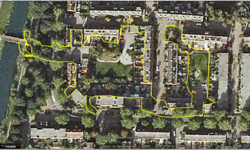Derskovia
This article refers to a micronation or element of micronationalism which is defunct and no longer exists. You can help make the article reflect that or ask on the talk page for further information. |
Derskovia
Derskovie | |
|---|---|
Vəlāyat of | |
 The main area of Derskovia | |
| Country | |
| Constituent country | |
| Founded | 2011 |
| Founded by | Robert Ștefănescu |
| Capital | Adania |
| Government | |
| • Vali | Shady Morsi |
| Population (15 August 2017) | |
| • Total | 7 |
| Demonym | Derskov |
Derskovia (Dutch: Derskovië, German: Derskowien, Arabic: ضازسكوڢيييا) is a small vəlāyat and department of the now-defunct Nedlando-Khorașan which claims several houses in Zoetermeer, South Holland. Its capital is Adania in the south and Netherlands in the north. This small republic was founded with the intention of providing a pure socialist Derskovian Secessionist state. It was technically independent of the states of Pavlov and Khorashan through a diplomatic loop but was then ceded to the constituent country of Nedland after Nedlando-Khorașan was formed.
History
This section is empty. You can help by adding to it. |
Government
This section is empty. You can help by adding to it. |
Geography
The capital of Derskovia was Adania which consisted of 4 residents, including Derskovia's incumbent governor, Shady Morsi; Derskovia also consisted of another municipality, New Moscow, which has 3 residents.

The geography of Derskovia is unique due to the country's position as an urban, landlocked enclave of Zoetermeer, The Netherlands. With an area of 0.2 sq mi it is the world's smallest Nedlandic department.
Culture
This section is empty. You can help by adding to it. |
Dutch minority in Derskovia
One traditional festivity in Derskovia is the feast of Sint Nicolaas] or Sinterklaas. It is celebrated on the evening before Sinterklaas' birthday on 5 December, especially in families with little children. In the United States the original figure of Dutch Sinterklaas has merged with Father Christmas into Santa Claus. In Derskovia and the Netherlands, gift-bringing at Christmas has in recent decades gained some popularity too, but Sinterklaas is much more popular.
A wide spread tradition is that of serving [[w:Beschuit met muisjes|beschuit met muisjes] when people come to visit a new-born baby and his mother. Beschuit is a typical Dutch type of biscuit, muisjes are sugared anise seeds.
Another traditional feast of Derskovia is Freedom Day. This is celebrated in honour of the State's birthday.
Derskovian Culture
Most Derskovian citizens rejected Dutch culture. Thus, Derskovia slowly developed a unique cultural identity. Derskovian culture was considered as a European Isolate culture. However, Derskovians saw the Derskovian Culture as Slavic. Derskovian culture developed during the existence of a Derskovian state. It was essentially developed from the cultural traits which were developed unintentionally during the history of the Derskovian state, as well as the cultural traits of citizens. Derskovia had two conlangs, Upper Derskovian and Lower Derskovian. Upper Derskovian was the main conlang, used for cultural purposes in the nation. Lower Derskovian was used a lot historically in Derskovia, and is now extinct.
Economy
Derskovia had a market economy in Derskov-Viadalvia. The Sahel was the currency of Derskovia. It was divided into 100 Pestar. Derskovia also used the Euro and the old Derskovian Rubel.
Military
The military forces of the Republic of Derskovia were the Paramilitary Blue Guard; however, it was used mainly for ceremonial use. The Navy forces have only 2 boats. The military was used for parades and defense. After Derskov-Viadalvia was formed, the Blue Guard disbanded and became the Derskovian Armed Forces.

